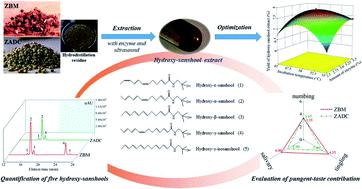Our official English website, www.x-mol.net, welcomes your
feedback! (Note: you will need to create a separate account there.)
Ultrasound-assisted enzymatic extraction of hydroxy-sanshool compounds from the hydrodistillation residue of two Sichuan peppers: optimization, quantification and pungent taste contribution evaluation
RSC Advances ( IF 3.9 ) Pub Date : 2021-1-22 , DOI: 10.1039/d0ra09234g Yuanlong Chi 1 , Yanglong Deng 1 , Shenghui Pu 1 , Yao Ren 1 , Zhifeng Zhao 1 , Qiang He 1
RSC Advances ( IF 3.9 ) Pub Date : 2021-1-22 , DOI: 10.1039/d0ra09234g Yuanlong Chi 1 , Yanglong Deng 1 , Shenghui Pu 1 , Yao Ren 1 , Zhifeng Zhao 1 , Qiang He 1
Affiliation

|
Hydroxy-sanshool compounds were extracted from the hydrodistillation residue of Z. bungeanum Maxim. pericarp (ZBM) and Z. armatum DC. pericarp (ZADC) by using ethanol–water extraction and extractions assisted with (i) enzymes, (ii) ultrasound, and (iii) enzymes and ultrasound. The yields of the hydroxy-sanshool extracts under these four extraction conditions were calculated and compared. The ultrasound-assisted enzymatic extraction was then optimized based on a Box–Behnken design. Furthermore, five hydroxy-sanshool compounds in the extracts were quantified and their pungent taste contribution value (PCV) was calculated. Oral sensory evaluation was finally performed. Compared with that of the hydroxy-sanshool extracted with ethanol–water, the yields of the samples from the extraction assisted with enzymes, ultrasound, and enzymes and ultrasound increased by 4.2–7.6%, 9.3–9.8%, and 21.5–26.2%, respectively. A maximum yield of 7.87% (w/w) was achieved by using ultrasound-assisted enzymatic extraction under the optimal conditions: 3.1% (w/w) amount of enzyme, an incubation temperature of 50.3 °C, and an ultrasound irradiation power of 207 W. The PCV of hydroxy-α-sanshool, hydroxy-β-sanshool, hydroxy-γ-sanshool, hydroxy-ε-sanshool, and hydroxy-γ-isosanshool was 1153, 447, 461, 139, and 51 ml g−1 for the ZBM extract, respectively, while the PCV of these five hydroxyl-sanshools was 659 ml g−1, 575 ml g−1, not detected, 119 ml g−1, and not detected for the ZADC extract, respectively. Tingling and salivation were the main taste sensations of ZBM, whereas numbing and tingling sensations were dominant in ZADC.
中文翻译:

超声辅助酶法提取两种花椒加氢蒸馏残渣中的羟基山椒素化合物:优化、定量和辛辣味贡献评价
羟基山椒素化合物是从白芨的加氢蒸馏残渣中提取的。果皮 (ZBM) 和Z. armatum直流。果皮(ZADC)通过使用乙醇-水提取和辅助提取(i)酶,(ii)超声,和(iii)酶和超声。计算并比较了这四种提取条件下羟基山椒素提取物的得率。然后基于 Box-Behnken 设计优化超声辅助酶提取。此外,对提取物中的五种羟基山椒素化合物进行了定量,并计算了它们的辛辣味贡献值(PCV)。最后进行了口腔感官评价。与乙醇-水提取的羟基山椒素相比,酶、超声、酶和超声辅助提取的样品得率分别提高了4.2-7.6%、9.3-9.8%和21.5-26.2%,分别。最大产量为 7。ZBM 提取物的 PCV 分别为-1,而 ZADC 提取物的这五种羟基山椒素的 PCV 分别为 659 ml g -1、575 ml g -1、未检测到、119 ml g -1和未检测到。刺痛和流涎是 ZBM 的主要味觉,而麻木和刺痛感在 ZADC 中占主导地位。
更新日期:2021-01-22
中文翻译:

超声辅助酶法提取两种花椒加氢蒸馏残渣中的羟基山椒素化合物:优化、定量和辛辣味贡献评价
羟基山椒素化合物是从白芨的加氢蒸馏残渣中提取的。果皮 (ZBM) 和Z. armatum直流。果皮(ZADC)通过使用乙醇-水提取和辅助提取(i)酶,(ii)超声,和(iii)酶和超声。计算并比较了这四种提取条件下羟基山椒素提取物的得率。然后基于 Box-Behnken 设计优化超声辅助酶提取。此外,对提取物中的五种羟基山椒素化合物进行了定量,并计算了它们的辛辣味贡献值(PCV)。最后进行了口腔感官评价。与乙醇-水提取的羟基山椒素相比,酶、超声、酶和超声辅助提取的样品得率分别提高了4.2-7.6%、9.3-9.8%和21.5-26.2%,分别。最大产量为 7。ZBM 提取物的 PCV 分别为-1,而 ZADC 提取物的这五种羟基山椒素的 PCV 分别为 659 ml g -1、575 ml g -1、未检测到、119 ml g -1和未检测到。刺痛和流涎是 ZBM 的主要味觉,而麻木和刺痛感在 ZADC 中占主导地位。











































 京公网安备 11010802027423号
京公网安备 11010802027423号